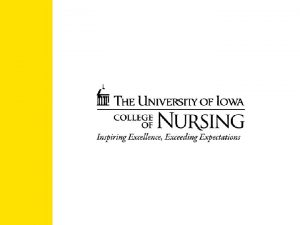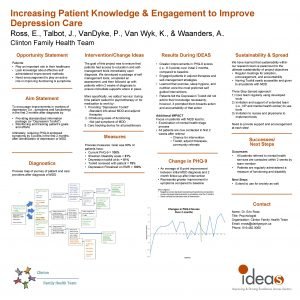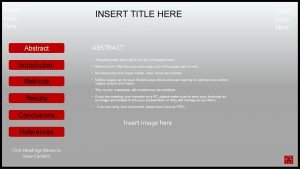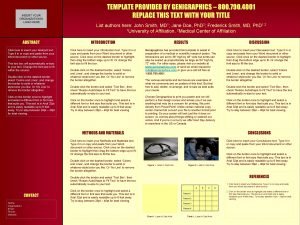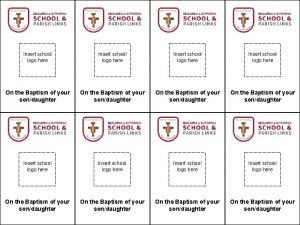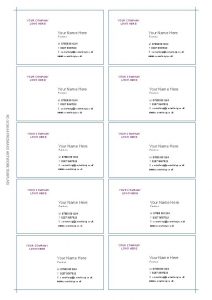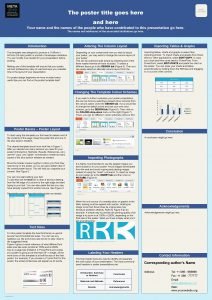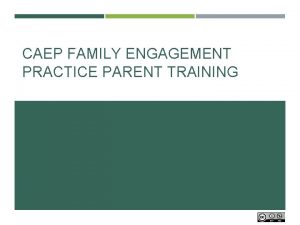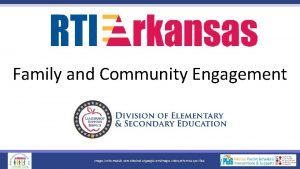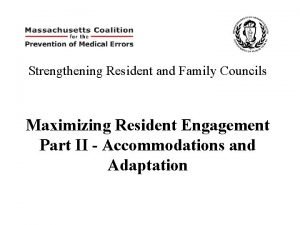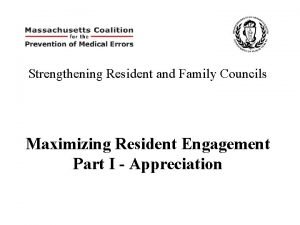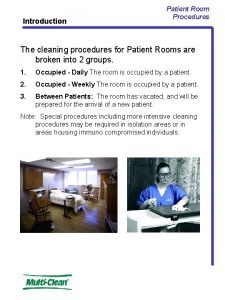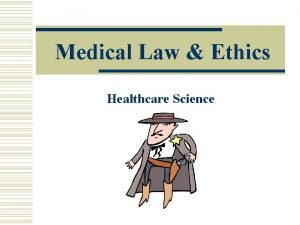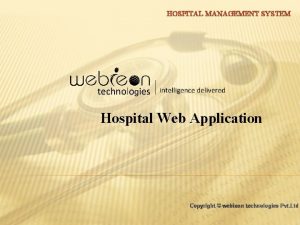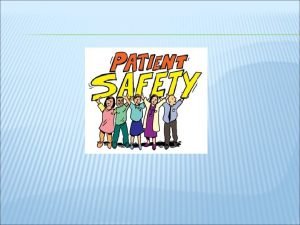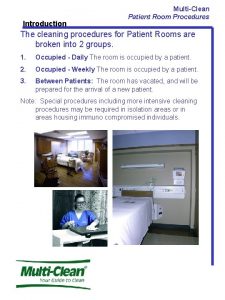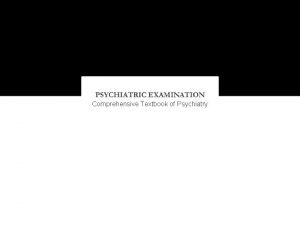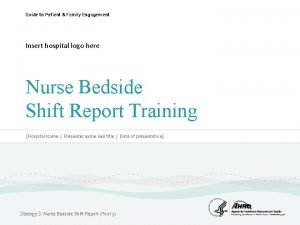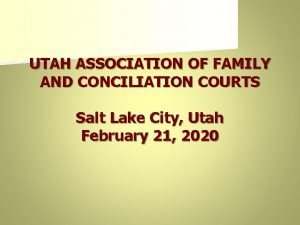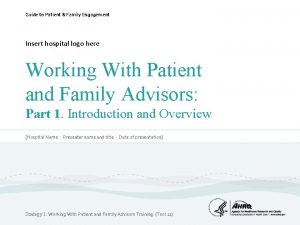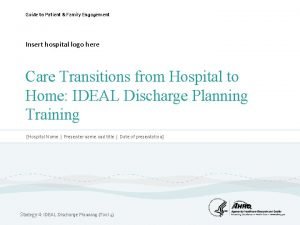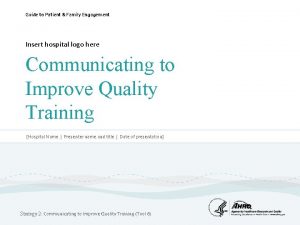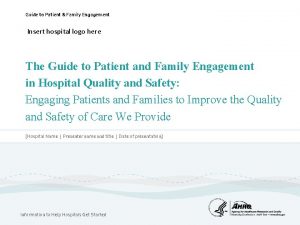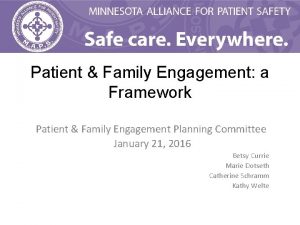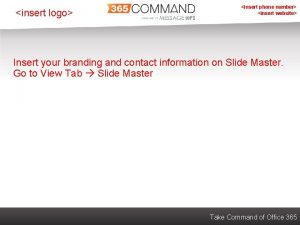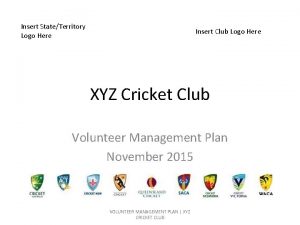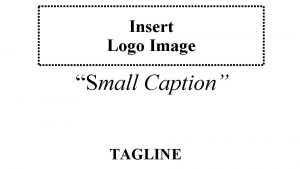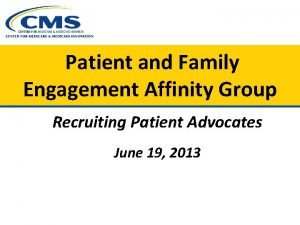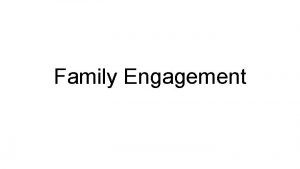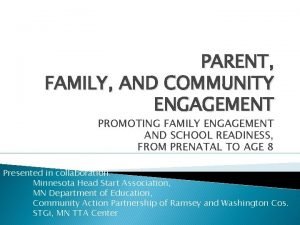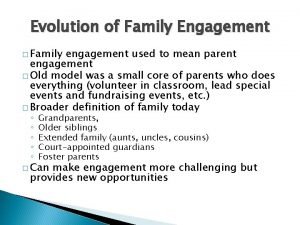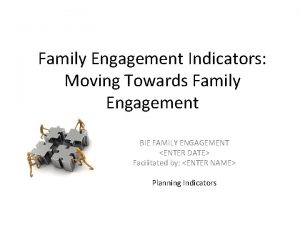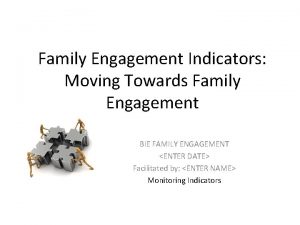Guide to Patient Family Engagement Insert hospital logo





![Why patient and family engagement? [Adapt to hospital] • [Include story from leadership about Why patient and family engagement? [Adapt to hospital] • [Include story from leadership about](https://slidetodoc.com/presentation_image_h/a8ebd0232fbc1a3a62fb20dcc7282893/image-6.jpg)

























- Slides: 31

Guide to Patient & Family Engagement Insert hospital logo here Nurse Bedside Shift Report Training [Hospital Name | Presenter name and title | Date of presentation] Strategy 3: Nurse Bedside Shift Report (Tool 3)

Today’s session • What is patient and family engagement? • What are the components of bedside shift report? • What are the benefits and challenges of bedside shift report? • What does HIPAA say about bedside shift report? • Practice exercises Strategy 3: Nurse Bedside Shift Report (Tool 3) 2

What is patient and family engagement? Strategy 3: Nurse Bedside Shift Report (Tool 3) 3

What is patient and family engagement? Patient and family engagement: • Creates an environment where patients, families, clinicians, and hospital staff all work together as partners to improve the quality and safety of hospital care • Involves patients and family members as: – Members of the health care team – Advisors working with clinicians and leaders to improve policies and procedures Strategy 3: Nurse Bedside Shift Report (Tool 3) 4

Patient- and family-centered care • Patient and family engagement is an important part of providing patient- and family-centered care • Core concepts of patient- and family-centered care: – – Dignity and respect Information sharing Involvement Collaboration Strategy 3: Bedside Shift Report 5
![Why patient and family engagement Adapt to hospital Include story from leadership about Why patient and family engagement? [Adapt to hospital] • [Include story from leadership about](https://slidetodoc.com/presentation_image_h/a8ebd0232fbc1a3a62fb20dcc7282893/image-6.jpg)
Why patient and family engagement? [Adapt to hospital] • [Include story from leadership about importance of patient and family engagement and goals for effort] • Research shows patient-centered approaches can improve: – Patient safety – Patient outcomes, including emotional health, functioning, and pain control – Patient experience • [Include specific goals / data for hospital] Strategy 3: Nurse Bedside Shift Report (Tool 3) 6

Why focus on bedside shift report? • Transitions in care have potential for medical errors • Research shows bedside shift report can improve: – Patient safety and quality • Improved communication • Decrease in hospital-acquired complications – Patient experiences of care – Time management and accountability between nurses • Decrease in time needed for shift report • Decrease in overshift time • [Include specific goals / data for hospital] Strategy 3: Nurse Bedside Shift Report (Tool 3) 7

What is the patient and family experience at our hospital? Strategy 3: Nurse Bedside Shift Report (Tool 3) 8

What is it like being a patient? Clinicians and hospital staff Patients and family • Know how the hospital works and how to get things done • Are strangers in this environment • Do n 0 t understand the system or culture • Know about their body and life situation better than hospital staff • Know who hospital staff are and what they do • Do not know who different staff are and what they do • May want family or friends to support them • May feel nursing staff are unavailable for multiple hours during shift change • Are busy and under a lot of stress • Are often in pain or uncomfortable, vulnerable, or afraid • Are worried and want to do what they can for the patient (family members) • Are aware that hospital staff are busy and may not want to bother you • Want to provide high-quality and safe care • Trust hospital staff to provide safe and quality care Strategy 3: Nurse Bedside Shift Report (Tool 3) 9

What is it like being a patient? (continued) • [Insert 1 to 2 experiences from real patients or family members, focus on what shift change feels like to the patient or family member: – Live presentation or story – Video – Vignette or quote] Strategy 3: Nurse Bedside Shift Report (Tool 3) 10

Bedside shift report • Critical elements • Benefits • Challenges Strategy 3: Nurse Bedside Shift Report (Tool 3) 11

What is bedside shift report? • Nursing staff conducts shift change reports at the patient’s bedside • Patient can identify a family member or close friend to participate • Report should take about 5 minutes per patient • Purpose: – To engage the patient and family in hospital care – To share accurate and useful information between nurses, patients, and families Strategy 3: Nurse Bedside Shift Report (Tool 3) 12

Critical elements of bedside shift report • Introduce the nursing staff, patient, and family. • Invite the patient and family to participate • Open medical record or electronic work station in the patient’s room • Conduct a verbal SBAR report with the patient and family, using words they can understand • Conduct a focused assessment of the patient and a safety assessment of the room • Review tasks that need to be done • Identify needs and concerns of the patient and family Strategy 3: Nurse Bedside Shift Report (Tool 3) 13

Benefits of bedside shift report for patients • Acknowledges patients as partners – “You do get the feeling of at least being wanted. You’re not just a patient in the bed. ” – “It makes you feel like you’re involved. ” • Builds trust in the care process – Shows the patient how much nurses know and do for them – Shows teamwork among the nursing staff, reassuring the patient that everyone knows what is going on with them Strategy 3: Nurse Bedside Shift Report (Tool 3) 14

Benefits of bedside shift report for patients (continued) • Encourages patient and family engagement – Gives the patient and family an opportunity to ask questions and correct any inaccuracies in handoff – Informs the patient and family members about the patient’s care throughout the stay and helps with the transition to home Strategy 3: Bedside Shift Report 15

Benefits of bedside shift report for nurses • • Better information about the patient’s condition Accountability Time management Patient safety Strategy 3: Nurse Bedside Shift Report (Tool 3) 16

Video of bedside shift report Strategy 3: Nurse Bedside Shift Report (Tool 3) 17

Video of bedside shift report (continued) • Discussion questions: – What are the overall impressions of the bedside shift report? – What went well? – What could have been done differently? – What questions or concerns do you have about bedside shift report? Strategy 3: Nurse Bedside Shift Report (Tool 3) 18

Tips for bedside shift report • Invite patients and family at admission to participate using bedside shift report brochure (Tool 1) • Use checklist to facilitate bedside shift report (Tool 2) • Don’t address a problem with the room or situation outgoing nurse in front of the patient • Thank the nurse going off duty if everything is in good shape Strategy 3: Nurse Bedside Shift Report (Tool 3) 19

Potential challenges • Unknown visitors or family in the room • New diagnosis or information patient is not yet aware of (e. g. , waiting for doctor to discuss) • Patient is asleep • Patient is noncompliant and you need to share information with oncoming nurse • Patient or family has a complex question or needs a lengthy clarification • Semi-private rooms and HIPAA concerns Strategy 3: Nurse Bedside Shift Report (Tool 3) 20

HIPAA and Bedside Shift Report Adapted from Emory University Bedside Shift Report Bundle Training Strategy 3: Nurse Bedside Shift Report (Tool 3) 21

Addressing HIPAA concerns • Health information can be disclosed for: – Treatment – Health care operations – Payment • HIPAA acknowledges incidental disclosures may occur • Not a HIPAA violation as long as – Take reasonable safeguards to protect privacy – Disclose only or use the minimum necessary information Strategy 3: Nurse Bedside Shift Report (Tool 3) 22

Addressing HIPAA concerns (continued) • Is a covered entity required to prevent any incidental use or disclosure of protected health information? • Answer: No. The HIPAA Privacy Rule does not require that all risk of incidental use or disclosure be eliminated to satisfy its standards. Rather, the rule requires only that covered entities implement reasonable safeguards to limit incidental uses or disclosures. See 45 CFR 164. 530(c)(2). Strategy 3: Nurse Bedside Shift Report (Tool 3) 23

Addressing HIPAA concerns (continued 2) • Can physicians and nurses engage in confidential conversations with other providers or with patients, even if there is a possibility that they could be overheard? • Answer: Yes. HIPAA does not prohibit providers from talking to each other and to their patients. Providers’ primary consideration is the appropriate treatment of their patients. Strategy 3: Nurse Bedside Shift Report (Tool 3) 24

Addressing HIPAA concerns (continued 3) • Oral communications often must occur freely and quickly. Covered entities are free to engage in communications as required for quick, effective, and high-quality health care. For example: – Coordinate services at nursing stations – Discuss a patient’s condition or treatment regimen in the patient’s semiprivate room – Discuss a patient’s condition during training rounds in an academic or training institution Strategy 3: Nurse Bedside Shift Report (Tool 3) 25

Practice exercises Strategy 3: Nurse Bedside Shift Report (Tool 3) 26

Option 1: Role play vignette • Jack, a 64 -year-old male with a history of chronic obstructive pulmonary disease, hypertension, and type 2 diabetes, was admitted to the unit this afternoon from the Emergency Department. His symptoms were severe morning headache with occasional vomiting for 3 days, chest pain, and shortness of breath. He received a dose of Zofran for vomiting before being brought up to the unit. During the initial nursing assessment, the nurse noticed a large bruise on his elbow and hip related to a recent fall. • It is time for evening shift change. During shift change, Jack notes he is slightly disoriented and drowsy and his headache has returned. Strategy 3: Nurse Bedside Shift Report (Tool 3) 27

Option 1: Role play vignette (continued) • Debrief – – – What did the nurses and Jack say to each other? How did you each feel during this interaction? What went really well? What could have been done differently? Anything else? Strategy 3: Nurse Bedside Shift Report (Tool 3) 28

Option 2: Small group discussion • Break into groups of X with one patient/family advisor in each group • Each person should discuss experience with shift report: What went well, what did not go well • Report back to large group Strategy 3: Nurse Bedside Shift Report (Tool 3) 29

Final thoughts • Our hospital is committed to patient and family engagement — everyone plays a critical part • Patients and families won’t engage if they believe that you don’t want them to—it is simply too risky for them • Your job is to make it safe for them to be involved, not just as patients but as partners in their care Strategy 3: Nurse Bedside Shift Report (Tool 3) 30

Thank you • For questions or more information – [Insert name, phone number, and email] Strategy 3: Nurse Bedside Shift Report (Tool 3) 31
 Patient engagement
Patient engagement Patient engagement depression
Patient engagement depression Insert logo here
Insert logo here Insert logo here
Insert logo here Insert logo here
Insert logo here Insert logo here
Insert logo here Your logo goes here
Your logo goes here Insert company logo here
Insert company logo here Please insert here
Please insert here Insert logo here
Insert logo here Insert logo here
Insert logo here Patient 2 patient
Patient 2 patient Caep family engagement
Caep family engagement Family engagement images
Family engagement images Resident and family engagement
Resident and family engagement Resident and family engagement
Resident and family engagement Hospital patient room cleaning procedures
Hospital patient room cleaning procedures Admission to hospital
Admission to hospital Rights of the patient in hospital
Rights of the patient in hospital Rights of the patient in hospital
Rights of the patient in hospital Rights of the patient in hospital
Rights of the patient in hospital Hospital management system patient registration form
Hospital management system patient registration form 2013 hospital national patient safety goals
2013 hospital national patient safety goals Hospital patient room cleaning procedures
Hospital patient room cleaning procedures 100 bedded hospital staff requirements
100 bedded hospital staff requirements Patient family
Patient family Hospital logo
Hospital logo Hospital logo
Hospital logo Family facilitator manual utah
Family facilitator manual utah Conjugal family
Conjugal family Varies from family to family on the periodic table
Varies from family to family on the periodic table Binuclear family vs blended family
Binuclear family vs blended family
